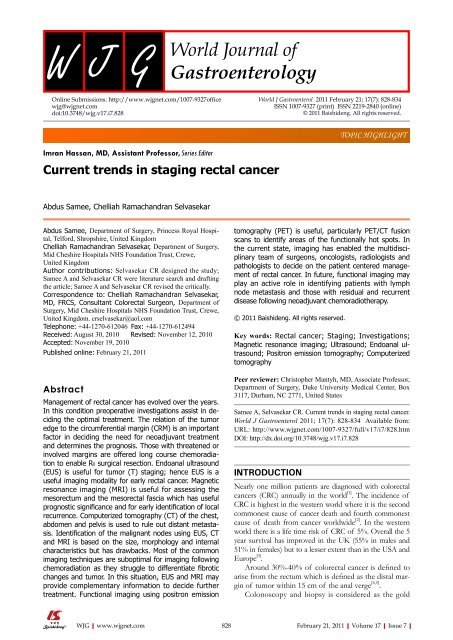Management of stage Ⅳ rectal cancer - World Journal of ...
Management of stage Ⅳ rectal cancer - World Journal of ...
Management of stage Ⅳ rectal cancer - World Journal of ...
Create successful ePaper yourself
Turn your PDF publications into a flip-book with our unique Google optimized e-Paper software.
Online Submissions: http://www.wjgnet.com/1007-9327<strong>of</strong>fice<br />
wjg@wjgnet.com<br />
doi:10.3748/wjg.v17.i7.828<br />
Imran Hassan, MD, Assistant Pr<strong>of</strong>essor, Series Editor<br />
Current trends in staging <strong>rectal</strong> <strong>cancer</strong><br />
Abdus Samee, Chelliah Ramachandran Selvasekar<br />
Abdus Samee, Department <strong>of</strong> Surgery, Princess Royal Hospital,<br />
Telford, Shropshire, United Kingdom<br />
Chelliah Ramachandran Selvasekar, Department <strong>of</strong> Surgery,<br />
Mid Cheshire Hospitals NHS Foundation Trust, Crewe,<br />
United Kingdom<br />
Author contributions: Selvasekar CR designed the study;<br />
Samee A and Selvasekar CR were literature search and drafting<br />
the article; Samee A and Selvasekar CR revised the critically.<br />
Correspondence to: Chelliah Ramachandran Selvasekar,<br />
MD, FRCS, Consultant Colo<strong>rectal</strong> Surgeon, Department <strong>of</strong><br />
Surgery, Mid Cheshire Hospitals NHS Foundation Trust, Crewe,<br />
United Kingdom. crselvasekar@aol.com<br />
Telephone: +44-1270-612046 Fax: +44-1270-612494<br />
Received: August 30, 2010 Revised: November 12, 2010<br />
Accepted: November 19, 2010<br />
Published online: February 21, 2011<br />
Abstract<br />
<strong>Management</strong> <strong>of</strong> <strong>rectal</strong> <strong>cancer</strong> has evolved over the years.<br />
In this condition preoperative investigations assist in deciding<br />
the optimal treatment. The relation <strong>of</strong> the tumor<br />
edge to the circumferential margin (CRM) is an important<br />
factor in deciding the need for neoadjuvant treatment<br />
and determines the prognosis. Those with threatened or<br />
involved margins are <strong>of</strong>fered long course chemoradiation<br />
to enable R0 surgical resection. Endoanal ultrasound<br />
(EUS) is useful for tumor (T) staging; hence EUS is a<br />
useful imaging modality for early <strong>rectal</strong> <strong>cancer</strong>. Magnetic<br />
resonance imaging (MRI) is useful for assessing the<br />
mesorectum and the meso<strong>rectal</strong> fascia which has useful<br />
prognostic significance and for early identification <strong>of</strong> local<br />
recurrence. Computerized tomography (CT) <strong>of</strong> the chest,<br />
abdomen and pelvis is used to rule out distant metastasis.<br />
Identification <strong>of</strong> the malignant nodes using EUS, CT<br />
and MRI is based on the size, morphology and internal<br />
characteristics but has drawbacks. Most <strong>of</strong> the common<br />
imaging techniques are suboptimal for imaging following<br />
chemoradiation as they struggle to differentiate fibrotic<br />
changes and tumor. In this situation, EUS and MRI may<br />
provide complementary information to decide further<br />
treatment. Functional imaging using positron emission<br />
WJG|www.wjgnet.com<br />
828<br />
<strong>World</strong> J Gastroenterol 2011 February 21; 17(7): 828-834<br />
ISSN 1007-9327 (print) ISSN 2219-2840 (online)<br />
© 2011 Baishideng. All rights reserved.<br />
tomography (PET) is useful, particularly PET/CT fusion<br />
scans to identify areas <strong>of</strong> the functionally hot spots. In<br />
the current state, imaging has enabled the multidisciplinary<br />
team <strong>of</strong> surgeons, oncologists, radiologists and<br />
pathologists to decide on the patient centered management<br />
<strong>of</strong> <strong>rectal</strong> <strong>cancer</strong>. In future, functional imaging may<br />
play an active role in identifying patients with lymph<br />
node metastasis and those with residual and recurrent<br />
disease following neoadjuvant chemoradiotherapy.<br />
© 2011 Baishideng. All rights reserved.<br />
Key words: Rectal <strong>cancer</strong>; Staging; Investigations;<br />
Magnetic resonance imaging; Ultrasound; Endoanal ultrasound;<br />
Positron emission tomography; Computerized<br />
tomography<br />
Peer reviewer: Christopher Mantyh, MD, Associate Pr<strong>of</strong>essor,<br />
Department <strong>of</strong> Surgery, Duke University Medical Center, Box<br />
3117, Durham, NC 2771, United States<br />
Samee A, Selvasekar CR. Current trends in staging <strong>rectal</strong> <strong>cancer</strong>.<br />
<strong>World</strong> J Gastroenterol 2011; 17(7): 828-834 Available from:<br />
URL: http://www.wjgnet.com/1007-9327/full/v17/i7/828.htm<br />
DOI: http://dx.doi.org/10.3748/wjg.v17.i7.828<br />
INTRODUCTION<br />
TOPIC HIGHLIGHT<br />
Nearly one million patients are diagnosed with colo<strong>rectal</strong><br />
<strong>cancer</strong>s (CRC) annually in the world [1] . The incidence <strong>of</strong><br />
CRC is highest in the western world where it is the second<br />
commonest cause <strong>of</strong> <strong>cancer</strong> death and fourth commonest<br />
cause <strong>of</strong> death from <strong>cancer</strong> worldwide [2] . In the western<br />
world there is a life time risk <strong>of</strong> CRC <strong>of</strong> 5%. Overall the 5<br />
year survival has improved in the UK (55% in males and<br />
51% in females) but to a lesser extent than in the USA and<br />
Europe [3] .<br />
Around 30%-40% <strong>of</strong> colo<strong>rectal</strong> <strong>cancer</strong> is defined to<br />
arise from the rectum which is defined as the distal margin<br />
<strong>of</strong> tumor within 15 cm <strong>of</strong> the anal verge [4,5] .<br />
Colonoscopy and biopsy is considered as the gold<br />
February 21, 2011|Volume 17|Issue 7|

















